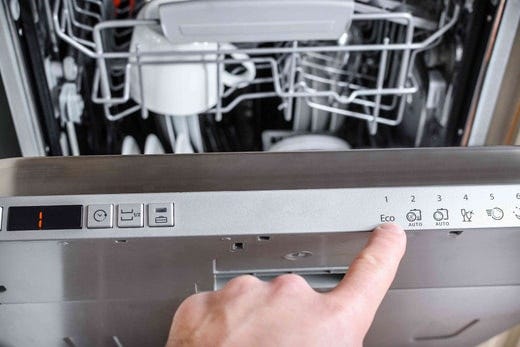
How to Reset a Dishwasher that Won’t Start

Dishwashers have enhanced our daily life by liberating us from the old-fashioned, elbow-grease dishwashing chore. They are efficient and convenient and produce sparkling clean dishwashing results with less time, effort, and water consumption.
But like every other indispensable appliance, dishwashers sometimes refuse to cooperate by not starting! But, before you think about spending big bucks on a professional technician or start considering expensive repairs, there is an option to try, i.e., resetting the dishwasher.
Read on to learn how to reset a dishwasher, helping you troubleshoot and resolve the issue without sweating.
Why is my dishwasher not starting?
Several factors could contribute to your dishwasher not starting. Ensuring the door is securely closed, checking the power supply, and regularly cleaning your dishwasher and filter can help you keep your dishwasher up.
Read through some of the most common causes and solutions below to discover why your dishwasher won’t start.
1. Control lock activated
The purpose of control lock settings is to avoid unintentional use or changes to wash cycle settings during the washing process. However, if the control lock is activated, it may also prevent the dishwasher from starting when you press the “start” button.
If the control lock is activated, pressing buttons on the control panel might cause a light to flash, depending on your model. Press and hold the Lock button for three seconds to deactivate the control lock mode. Refer to your owner’s manual for precise instructions.
2. Sleep mode is activated
Some dishwashers can go into sleep or standby mode when they aren’t in use. Deactivate the sleep mode by opening and closing the dishwasher door or pressing the “Start/Resume” or “Cancel” button.
3. Delay wash option is activated
Certain dishwashers offer a delay wash feature, allowing you to load dishes, add detergent, and schedule the cycle to begin later. Dishwashers with this feature typically display a delay indicator or countdown.
After selecting the delay wash, press the “Start/Resume” button within 30 seconds to initiate the countdown; otherwise, the dishwasher may deactivate.
To cancel the delay wash, reselect the delay button while the countdown is active, promptly start the dishwasher, and turn off the delay indicator light.
Learn about the delay feature and other dishwasher programs, settings, and cycles to determine which ones you should use with every wash.
4. Door unlatched
Sometimes, an unlatched dishwasher door can appear close to the naked eye. Ensure the door is properly closed before trying to start the cycle.
If the door isn’t latched, check whether the lower dish rack is installed correctly, as an incorrectly installed rack can prevent the complete door closure.
5. Disconnected power supply
Your dishwasher may be connected directly to an electrical circuit instead of plugged into an outlet. The problem with hardwiring is that it increases the likelihood of dishwasher tripping and requiring resetting.
Locate the circuit breaker linked to your dishwasher in the electrical panel, turn it off for a few seconds, and then switch it back on.
How to reset a dishwasher
The process of resetting your dishwasher varies depending on brand and model type. Some models require powering down the dishwasher by unplugging it or switching off the circuit breaker.
Others require pressing and holding the “Start/Reset” button on the control panel, followed by a brief pause before activating a wash cycle.
To disconnect the power of a hardwired dishwasher, turn off the circuit breaker connected to your dishwasher for a minute, then turn it back on. For dishwashers plugged into an outlet, disconnect the plug for a minute, then reconnect it.
.png?width=70&height=45&format=png&quality=50)
